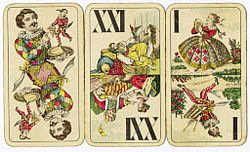Cartes de Suisses The “Cartes de Suisses” is a name sometimes given to an 18th-century standard pattern of Tarot playing cards that were initially produced in Rouen, and later in the Austrian Netherlands as well as in the Prince-Bishopric of Liège,[1] now both part of Belgium. As a result they are also referred to as Flemish or Belgian Tarot.[2] They are better called “Rouen/Brussels pattern”.[3] There is no evidence that this type of Tarot cards was ever manufactured in Switzerland. HistoryBackgroundTarot playing cards emerged in the early 15th century in northern Italy, the first documented packs being associated with Milan, Ferrara, Florence and Bologna when an additional set of trumps known as trionfi were added to a standard, Italian-suited pack with the four suits: Swords, Batons, Cups and Coins.[4][5] The earliest surviving examples are the Visconti-Sforza Tarot packs painted in the mid-15th century for the Dukes of Milan.[6] Because the earliest tarot cards were hand-painted, they were probably only produced in small numbers. However, the advent of the printing press enabled the mass production of cards and their spread elsewhere. The expansion of tarot outside of Italy, first to France and Switzerland, occurred during the Italian Wars. The most prominent tarot deck version used in these two countries was the Tarot of Marseilles, of Milanese origin.[7] Emergence and spread of Cartes de SuissesAlthough it is said that “In the late 16th century a heavy French tax on playing card manufacture drove many cardmakers to emigrate to Switzerland where they created a new design of tarot pack that became known as Cartes de Suisses.[8]”, there is absolutely no evidence for such an emigration. In Switzerland, the manufacture of playing cards was dying and ceased completely in the early 17th century, and the Swiss had to import their playing cards from Épinal (then in the Duchy of Lorraine) and Lyon.[9] The design of the so-called Cartes de Suisses cannot have been set up in Switzerland. On the contrary, these cards appear to have a strong Italian underlying design with a clear layer of Norman details added. From Rouen they were exported to the Low Countries and Liège. This pattern was adopted by cardmakers in the Austrian Netherlands perhaps as a result of the spread of a Swiss tarot card game, such as Troggu, to that part of the world during the 18th century. There were many Swiss mercenaries in the Dutch service garrisoned in the Austrian Netherlands. At that time this design became a standard pattern there in the 18th century, the name Cartes de Suisses being retained.[10] In 1849, for example, a pack of "Swiss Tarots, Cartes de Suisses" is advertised for sale in a catalogue. The description notes that it was made in Brussels by F. J. Vandenborre, cardmaker, and comprises 78 cards, "the Coat Cards are exceedingly curious, representing Bacchus, Love, Death, the Devil, Lightning, Sun, Moon, Stars, Day of Judgement, Fool, &c."[11] The name Flemish Tarot was given because the cards were thought to be made in the Flemish-speaking part of the Austrian Netherlands.[8] However, this an error: the places were they were made – Brussels, Bouvignes, Liège, Dinant – were all out of Flanders. CardsThe Cartes de Suisses pattern is different from the Tarot de Marseilles, its key distinguishing features being:[8]
The designs on many of the tarots are also different. For example, The Star depicts a seated astronomer instead of a kneeling woman.[8] They clearly come from another Italian tradition. The pictures below portray the 22 trump cards of the Cartes de Suisses:
References
Bibliography
|
Portal di Ensiklopedia Dunia



































